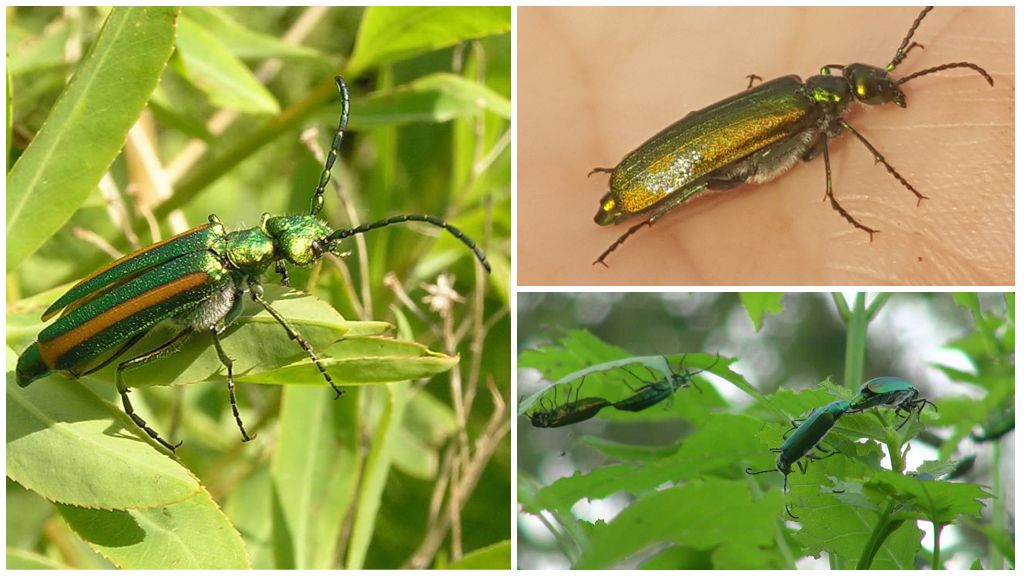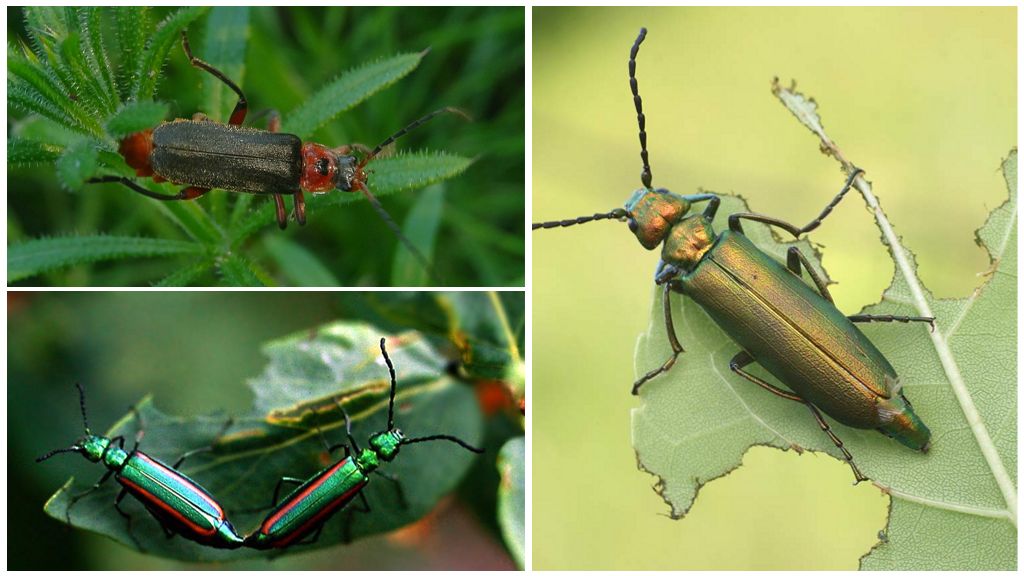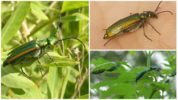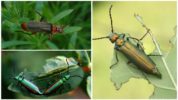- Beetle Spaniard Fly
- Beetle Spaniard Fly
Beetle shpanka, aka shpanskaya fly (lat.Lytta vesicatoria) belongs to the family nairnikov. Coleoptera with an oblong body, small head, long curled mustache, beautiful colors is malicious pest of garden crops. It lives on plants of the olive family, honeysuckle. About 30 species inhabit the territory of Russia; they prefer the southern, central regions.
Description of appearance
Beetle flypan has 3 subspecies:
- Lytta vesicatoria moreana. Ash punch. The most common species in our area. Beetles are bright green with a metallic, blue tint. The head is down, there are long mustaches located close to the eyes. The chest is small, the main part of the body is a long thin abdomen. The size of an adult bunny beetle is 11-21 mm.
- Lytta vesicatoria togata. It features a unique, attractive color. The main color is green, blue with a metallic sheen. On the abdomen on the sides are long yellow stripes. Body shape, dimensions are identical to the ash tree.
- Lytta vesicatoria vesicatoria. The red-headed spanky at the imago stage eats potatoes, beets, soybeans, gourds, and rarely cereals. Outwardly different in the color of the head - red, the body is green with a yellow tint.
Interesting!
Found a shpunkka originally in Spain. The owners of olive plantations lost their crops in just a few days, finding trees completely without leaves, fruits, only twigs. The news quickly spread throughout Europe, the pest was given the name of a Spanish or Spanish fly, and later, the Pencilvanese. Photo bugs below.
Lifestyle, nutrition
An adult lives on trees and feeds on leaves. Prefers poplar, clear, maple. Often starts on a lilac, olives, forest crops. Beetles fly actively from May to August in sunny weather. At night, they sit motionless on the trees, clinging to the leaves with strong paws.
On a note!
The insect creeper tolerates drought well, adapts to weather conditions, has excellent appetite. During the day, a colony of pests eats up the middle bush of lilacs cleanly, within a few weeks destroys the ash forest.

The mating season begins in late May. The female descends under the roots of the trees, lays eggs in heaps of 50 pieces in the soil. Over the entire warm season, one female reproduces 1,000 larvae. Embryos develop for several days, then small black larvae appear - caterpillars. They make their way into the nests of earthen wasps, bumblebees, destroy stocks of nectar, honey, offspring.
Life cycle
Black beetle, green, blue, yellow lives only one summer, dies with the onset of cold weather. Larvae live underground, go through a long development cycle. Shedding up to 7 times, by the end of summer they turn into a false pupa, winter.
In the spring, they continue to develop, mutate, and also turn into a larva. After a few days, they pupate, a young bug appears, gets to the surface. It rises to the crowns of trees, actively eats, then the mating season begins, laying eggs.
On a note!
Unlike adult shanks, the larvae are not so voracious; they can be without food for a year. Under adverse conditions, development stops.
Harm and Benefit
With a large number of flies, there is a specific smell that cannot be confused with anything. It smells like mice. The beetle secretes a substance that causes irritation of the skin, a strong allergic reaction. When it enters the digestive tract, it provokes intoxication - diarrhea with blood, vomiting, nausea, weakness, erectile dysfunction in men, increased blood pressure, etc. A fatal dose for a person is 80 g of poison.
In the last century, a powder containing cantharidin obtained from the body of a bobbin was used for medical purposes to treat corns and abscesses on the skin. Patches were made. Later, the substance was replaced with synthetic analogues, the production of the drug stopped.

A love elixir for men and women is made from the secret of a flypan. In acceptable doses, improves erection, increases sexual desire. Drugs are actively sold through the Internet, sold in a sex shop. Exceeding the dosage is dangerous with an increase in blood pressure, weakness, malaise. As well as a painful erection, hypertensive crisis, shock.
Interesting!
In ancient Rome, the treacherous wife of Octavian Augustus poured powder on the fly to guests to liberate their desires and then blackmail. Lovelace Marquis de Sade was accused of using the powder. The fortuneteller, the sorceress La Voisel, offered a love potion based on the fly, blood of a mole, and a bat.
In nature, the beetle is a pest of honeysuckle, olive plants. With mass distribution, it threatens the extermination of the forest, garden, and park. Control measures are selected depending on the number of pests, give preference to chemistry.
How to deal with a beetle
To save plants from certain death, adult individuals need to be poisoned. Experts recommend the use of contact-intestinal insecticides. Often used Karbofos. The solution is prepared immediately before use. The death of a pest colony occurs within the first 2 days.
A much more complicated question is how to get rid of larvae. There are no effective methods of struggle. Larvae develop in nests of earthen wasps, bumblebees. To destroy parasites, you need to destroy the hives of other insects, which is not entirely humane. The only option is to wait for the appearance of adult beetles, timely treat the trees with poison.
Spray the plants in May, but a few weeks before flowering. Otherwise, insects pollinating flowers will die. Reprocessing is carried out after the inflorescences have fallen. The risk of tree infection remains until the end of summer. Poison is valid for a maximum of 30 days.
A small number of flies can be collected manually, destroyed or thrown away from their own possessions. Be sure to use rubber gloves, and then wash your hands well with soap.





